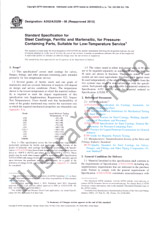Potřebujeme váš souhlas k využití jednotlivých dat, aby se vám mimo jiné mohly ukazovat informace týkající se vašich zájmů. Souhlas udělíte kliknutím na tlačítko „OK“.
ASTM C1361-10(2019)
Standard Practice for Constant-Amplitude, Axial, Tension-Tension Cyclic Fatigue of Advanced Ceramics at Ambient Temperatures
Přeložit název
NORMA vydána dne 1.7.2019
Informace o normě:
Označení normy: ASTM C1361-10(2019)
Poznámka: NEPLATNÁ
Datum vydání normy: 1.7.2019
Kód zboží: NS-953485
Počet stran: 9
Přibližná hmotnost: 27 g (0.06 liber)
Země: Americká technická norma
Kategorie: Technické normy ASTM
Kategorie - podobné normy:
Anotace textu normy ASTM C1361-10(2019) :
Keywords:
advanced ceramic, S-N curve, tension-tension cyclic fatigue,, ICS Number Code 81.060.30 (Advanced ceramics)
Doplňující informace
| Significance and Use | ||||||||||||||||||||||||||
|
4.1 This practice may be used for material development, material comparison, quality assurance, characterization, reliability assessment, and design data generation. 4.2 High-strength, monolithic advanced ceramic materials are generally characterized by small grain sizes (<50 μm) and bulk densities near the theoretical density. These materials are candidates for load-bearing structural applications requiring high degrees of wear and corrosion resistance, and high-temperature strength. Although flexural test methods are commonly used to evaluate strength of advanced ceramics, the nonuniform stress distribution in a flexure specimen limits the volume of material subjected to the maximum applied stress at fracture. Uniaxially loaded tensile strength tests may provide information on strength-limiting flaws from a greater volume of uniformly stressed material. 4.3 Cyclic fatigue by its nature is a probabilistic phenomenon as discussed in STP 91A and STP 588 4.4 Tensile cyclic fatigue tests provide information on the material response under fluctuating uniaxial tensile stresses. Uniform stress states are required to effectively evaluate any nonlinear stress-strain behavior which may develop as the result of cumulative damage processes (for example, microcracking, cyclic fatigue crack growth, etc.). 4.5 Cumulative damage processes due to cyclic fatigue may be influenced by testing mode, testing rate (related to frequency), differences between maximum and minimum force (4.6 The results of cyclic fatigue tests of specimens fabricated to standardized dimensions from a particular material or selected portions of a part, or both, may not totally represent the cyclic fatigue behavior of the entire full-size end product or its in-service behavior in different environments. 4.7 However, for quality control purposes, results derived from standardized tensile test specimens may be considered indicative of the response of the material from which they were taken for given primary processing conditions and post-processing heat treatments. 4.8 The cyclic fatigue behavior of an advanced ceramic is dependent on its inherent resistance to fracture, the presence of flaws, or damage accumulation processes, or both. There can be significant damage in the test specimen without any visual evidence such as the occurrence of a macroscopic crack. This can result in a specific loss of stiffness and retained strength. Depending on the purpose for which the test is being conducted, rather than final fracture, a specific loss in stiffness or retained strength may constitute failure. In cases where fracture occurs, analysis of fracture surfaces and fractography, though beyond the scope of this practice, are recommended. |
||||||||||||||||||||||||||
| 1. Scope | ||||||||||||||||||||||||||
|
1.1 This practice covers the determination of constant-amplitude, axial, tension-tension cyclic fatigue behavior and performance of advanced ceramics at ambient temperatures to establish “baseline” cyclic fatigue performance. This practice builds on experience and existing standards in tensile testing advanced ceramics at ambient temperatures and addresses various suggested test specimen geometries, test specimen fabrication methods, testing modes (force, displacement, or strain control), testing rates and frequencies, allowable bending, and procedures for data collection and reporting. This practice does not apply to axial cyclic fatigue tests of components or parts (that is, machine elements with nonuniform or multiaxial stress states). 1.2 This practice applies primarily to advanced ceramics that macroscopically exhibit isotropic, homogeneous, continuous behavior. While this practice applies primarily to monolithic advanced ceramics, certain whisker- or particle-reinforced composite ceramics, as well as certain discontinuous fibre-reinforced composite ceramics, may also meet these macroscopic behavior assumptions. Generally, continuous fibre-reinforced ceramic composites (CFCCs) do not macroscopically exhibit isotropic, homogeneous, continuous behavior and application of this practice to these materials is not recommended. 1.3 The values stated in SI units are to be regarded as the standard and are in accordance with IEEE/ASTM SI 10. 1.4 This standard does not purport to address all of the safety concerns, if any, associated with its use. It is the responsibility of the user of this standard to establish appropriate safety, health, and environmental practices and determine the applicability of regulatory limitations prior to use. 1.5 This international standard was developed in accordance with internationally recognized principles on standardization established in the Decision on Principles for the Development of International Standards, Guides and Recommendations issued by the World Trade Organization Technical Barriers to Trade (TBT) Committee. |
||||||||||||||||||||||||||
| 2. Referenced Documents | ||||||||||||||||||||||||||
|




 Cookies
Cookies
